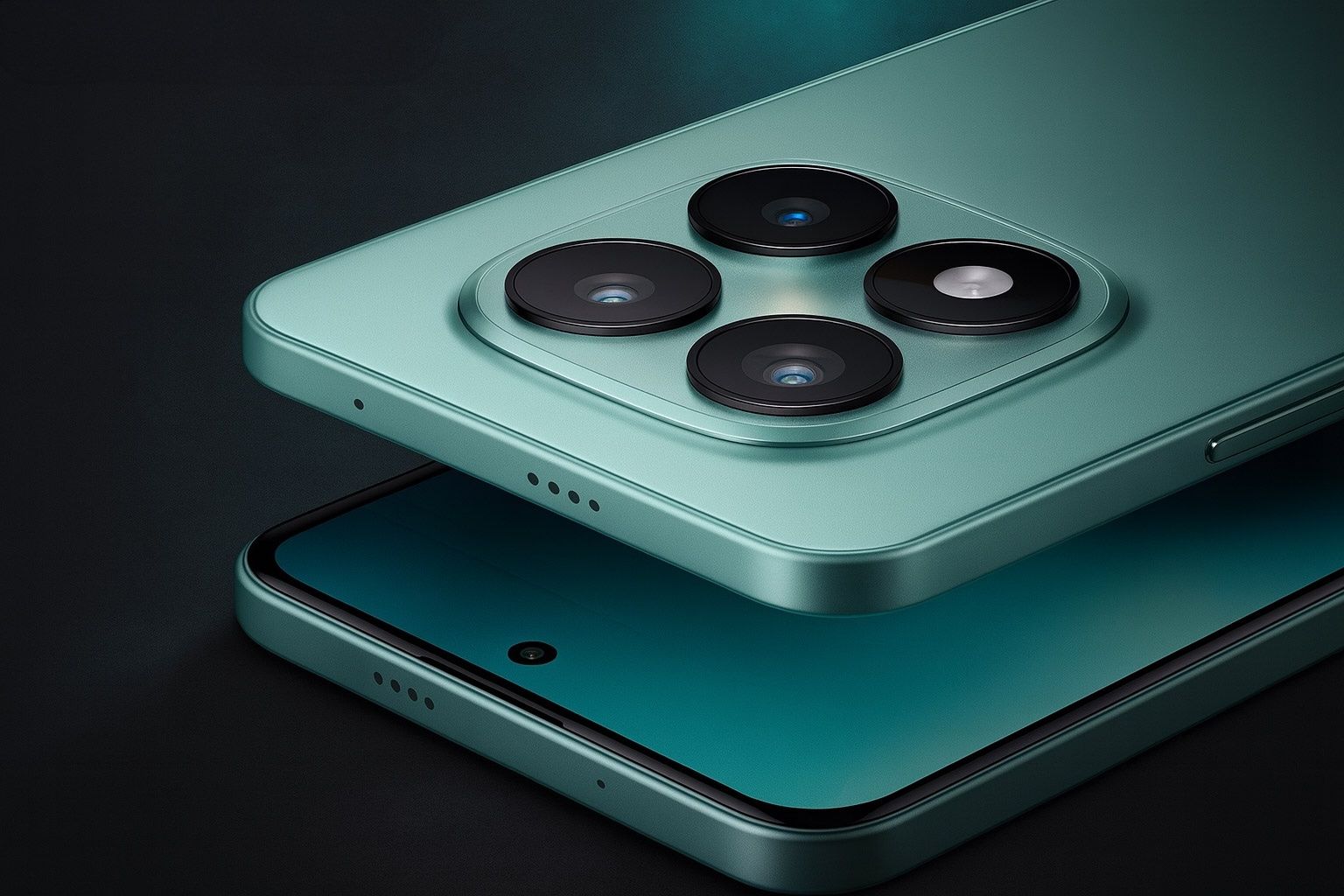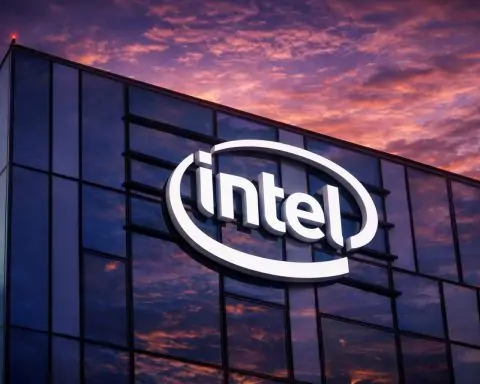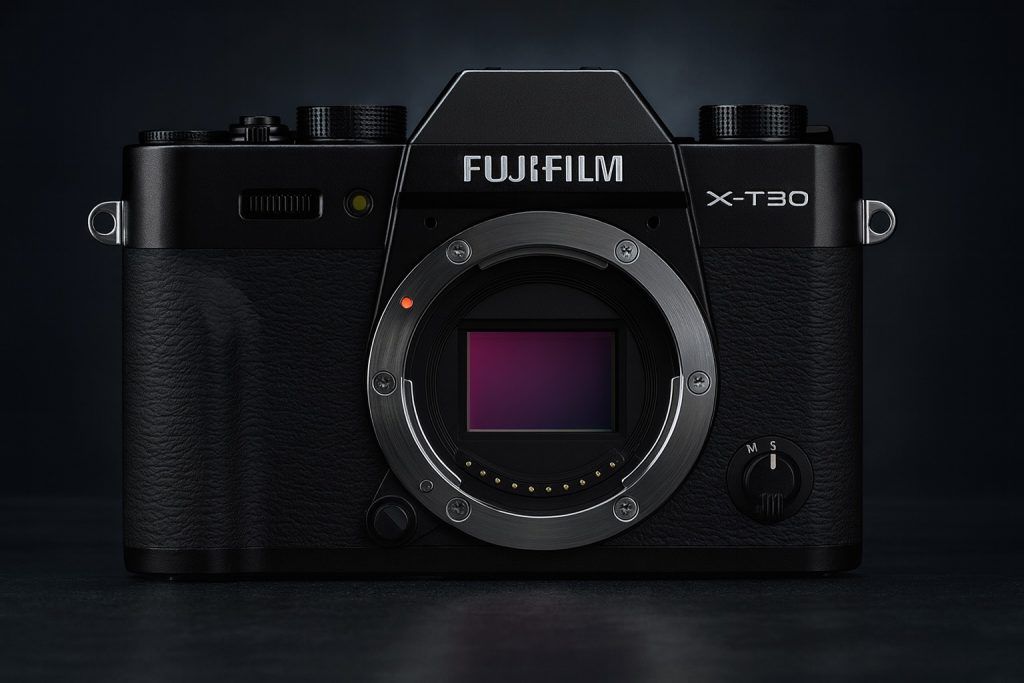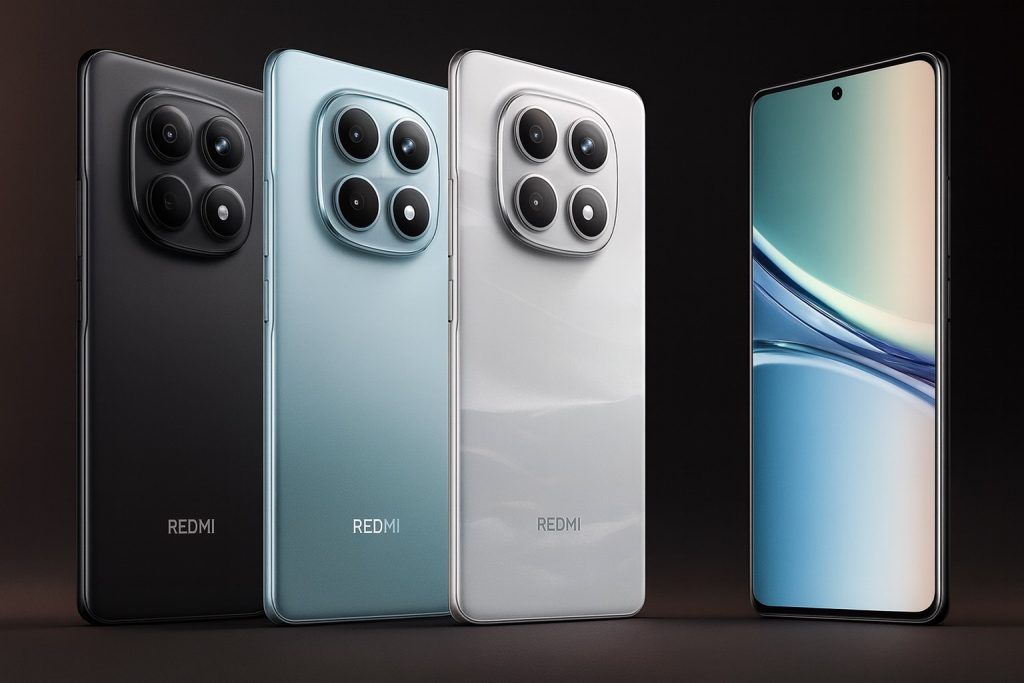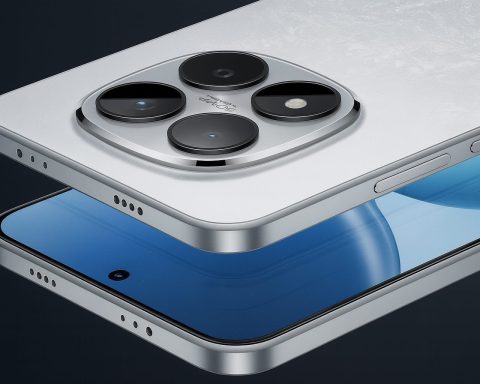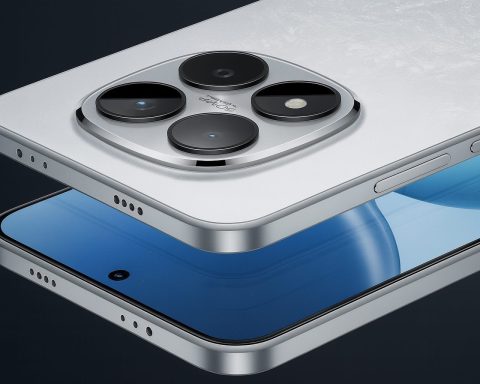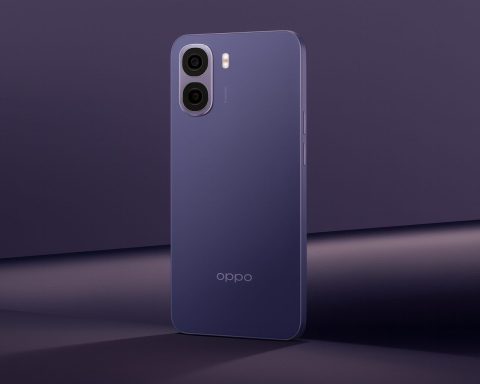- The Redmi Note 15 family comprises three main models: the base Note 15, the Note 15 Pro, and a rumored Note 15R.
- The Note 15 base features a 5,800 mAh battery with 45W fast charging and 18W reverse wired charging.
- The Note 15 base has a 6.77-inch OLED display at 120 Hz with up to 3,200 nits peak brightness.
- The Note 15 Pro runs on the MediaTek Dimensity 7400-Ultra (4 nm, up to 2.6 GHz) with 8/12 GB RAM and up to 512 GB storage, while the Pro+ adds up to 16 GB RAM and an advanced cooling system.
- The Note 15 Pro and Pro+ use Dragon Crystal Glass with fiberglass back, offer IP66/IP68/IP69/IP69K ratings, and have endured 2-meter drops onto granite 50 times in tests.
- The base Note 15 uses a 50 MP Light Hunter 400 main camera with 2 MP depth and no ultrawide, while the Pro uses a 50 MP Sony LYT-600 with OIS plus an 8 MP ultrawide and 2 MP macro.
- The Redmi Note 15 Pro+ adds a 50 MP telephoto camera and a curved display, in addition to 90 W charging capability.
- All Note 15 phones ship with Android 15 and HyperOS 2, with a promise of 2 years of major OS updates and 4 years of security patches, plus Wet Touch 2.0 on the Pro models.
- China launch prices start at CNY 999 for the Note 15, CNY 1,499 for the Note 15 Pro, CNY 1,999 for the Note 15 Pro+, and the Note 15R is rumored around CNY 1,099.
- In India, the Redmi 15 5G (global Note 15) launched on August 28, 2025 at ₹14,999 for 6+128 GB and ₹16,999 for 8+256 GB, signaling global expansion into late 2025 or early 2026.
Xiaomi’s Redmi Note 15 lineup has arrived with a bang – literally, in terms of big batteries and rugged design. The series includes the standard Redmi Note 15, an upgraded Redmi Note 15 Pro, and even talk of a more affordable Redmi Note 15R. These phones aim to offer as much value as possible for the price, bringing major upgrades over the previous model – from bigger batteries to brighter screens, while balancing performance, design, and price like never before [1]. The Note 15 Pro models in particular are being touted as the most durable and long-lasting Note phones yet, packing one of the largest batteries seen in this lineup and high-end features like IP68/IP69 water resistance [2] [3]. Meanwhile, the standard Note 15 keeps many perks (like a 120Hz OLED display and fast charging) at a lower price [4]. In this report, we’ll compare the Redmi Note 15, Note 15 Pro, and what’s known about the rumored Note 15R across specifications, features, design, software, battery life, display, camera quality, performance, and pricing. We’ll also quote expert reviewers’ insights and peek at upcoming models (like whispers of a Note 15 Ultra or the next Note 16 series). Let’s dive into how these devices stack up and which might be best for budget-conscious users, gamers, or mobile photographers.
Specs Comparison at a Glance
Before breaking down each aspect, here’s a quick feature comparison table summarizing the core specs of the Redmi Note 15, 15 Pro, and the purported 15R:
| Feature | Redmi Note 15 (5G) | Redmi Note 15 Pro (5G) | Redmi Note 15R (5G) |
|---|---|---|---|
| Display | 6.77″ FHD+ OLED, 120 Hz, ~3200 nits [5] [6] | 6.83″ 1.5K OLED, 120 Hz, ~3200 nits [7] [8] | 6.79″ (likely FHD+, ~90–120 Hz) – rumored [9] [10] |
| Processor | Snapdragon 6 Gen 3 (4 nm, up to 2.4 GHz) [11] | MediaTek Dimensity 7400-Ultra (4 nm, 2.6 GHz) [12] | Expected mid-range Snapdragon or Dimensity – TBD |
| RAM & Storage | 6/8/12 GB LPDDR4X, 128–256 GB UFS 2.2 [13] [14] | 8/12 GB (up to 16 GB on Pro+), 256–512 GB UFS 3.1 [15] [16] | Rumored 6 GB base, up to 128–256 GB [17] [18] |
| Rear Cameras | Dual: 50 MP main (Light Fusion 400) + 2 MP depth [19] [20]; no ultra-wide | Triple: 50 MP main (Sony LYT-600, f/1.5, OIS) + 8 MP ultra-wide + 2 MP macro [21] [22] | Dual (expected): 50 MP main + low-MP secondary (depth/macro) – rumored |
| Front Camera | 8 MP (f/2.0) selfie [23] [24] | 20 MP selfie (Pro); 32 MP on Pro+ model [25] [26] | Likely ~8 MP – rumored |
| Battery | 5,800 mAh, 45 W fast charge, 18 W reverse [27] [28] | 7,000 mAh, 45 W (Pro) / 90 W (Pro+), 22.5 W reverse [29] [30] | ~5,000 mAh (est. 5,000–5,300), fast charging TBD [31] [32] |
| Design & Build | Glass front, ~7.35 mm thick, 178 g [33]; IP66 splash resistant [34] [35]; curved screen design | Dragon Crystal Glass + fiberglass back [36] [37]; IP68/IP69K water resistant [38]; Pro: flat display, Pro+ curved display [39] | Likely plastic frame; unknown IP rating; design possibly like Redmi 12 series – rumored [40] |
| Software | Android 15 with HyperOS 2 (new MIUI successor) [41] – 2 years OS & 4 years security updates promised [42] | Android 15 with HyperOS 2 (includes features like Wet Touch 2.0 for use with wet screen) [43] | Expected Android 15 (HyperOS) – unconfirmed |
| Starting Price (China) | CNY 999 (~$140) for 6+128GB [44] [45] | CNY 1,499 (~$210) for 8+256GB [46] | Expected ~CNY 1,099–1,199 (if it launches) – rumored [47] |
Note: The Redmi Note 15R has not been officially announced as of August 2025; its specs above are speculative based on leaks/past trends. The Redmi Note 15 Pro+ (a higher-end sibling with a Snapdragon 7s Gen4 chip and 50 MP telephoto camera [48]) is also part of the series but is beyond our main comparison scope. All Chinese prices cited are for the domestic market – global pricing may differ if/when these models launch internationally.
Design and Build Quality
In terms of design, the Redmi Note 15 Pro duo emphasizes durability. Xiaomi has used tough materials like “Dragon Crystal Glass” on the display and an ultra-tough fiberglass back, enabling the phones to survive 2-meter drops onto granite (tested 50 times) [49]. Both the Pro and Pro+ boast IP66, IP68, IP69, and even IP69K ingress ratings [50], meaning they’re not just dust-proof and dunk-proof, but can even withstand high-pressure water jets – an extremely rare level of waterproofing in mid-range phones. “Xiaomi clearly wants these phones to stand out for durability… one of the toughest Redmi phones ever built,” notes one reviewer [51]. In practical terms, this rugged build is great news for clumsy users or anyone who needs a phone that can handle rough conditions. The Pro models are a bit hefty due to the gigantic battery (the Note 15 Pro+ especially, at over 200g), but still manage a sleek look with semi-flat displays and thin, rounded edges [52]. Notably, the Note 15 Pro has a flat screen, whereas the Pro+ gets a curved display for a more “premium” look [53]. Both have symmetrical dual stereo speakers and even support “Wet Touch” modes so you can use the screen with wet fingers (complementing their waterproof nature) [54].
The standard Redmi Note 15, while more budget-oriented, doesn’t feel cheap either. It’s impressively slim (about 7.35 mm) and light (178g) [55] – much thinner and less “brick-like” than the Pro models. In fact, one hands-on report mentions that after handling the Pro+, the regular Note 15 “feels easier to handle – slimmer, less of a brick in the pocket.” [56] The Note 15 retains a glass front (with an in-display fingerprint reader) and has an IP66 rating for dust and splash resistance [57], which should survive rain or a coffee spill. Its design is a bit more conventional: a rounded 6.77-inch display (some sources say it has subtly curved edges similar to last year’s Note 14 Pro) and a plastic frame. Xiaomi offers the base model in tasteful colors like Midnight Black, Star White, and Sky Blue (all with matching colored camera housings) [58] [59], giving it a clean, minimalist aesthetic. Reviewers note the white model “looks clean and a bit more premium than you’d expect at this level.” [60]
As for the Redmi Note 15R, details on build are scarce. If it follows the pattern of the earlier Redmi Note 12R, it may use a plastic frame and back to cut costs, possibly resembling the Redmi 12 series design [61] [62]. We wouldn’t expect high-end glass or fancy durability ratings here – likely just basic splash resistance (if any). The 15R is rumored in Black or Gold finishes [63]. Until it’s officially unveiled, one can assume the 15R will be the most utilitarian in design, trading the premium touches of its siblings for a lower price tag.
Display Quality
All Redmi Note 15 variants aim to deliver strong displays for their class. The Redmi Note 15 sports a 6.77-inch OLED screen with a Full HD+ resolution (~1080×2400) and a smooth 120Hz refresh rate [64]. Incredibly, Xiaomi claims this panel can reach 3,200 nits peak brightness [65] – an almost unheard-of figure that outshines even many flagships. While typical usage won’t hit that peak often, it means the Note 15 remains very readable even under harsh sunlight. “On paper, [3200 nits] is almost ridiculous for a phone in this price bracket,” one tech writer observed, noting that most users won’t notice much difference beyond ~2000 nits except in direct sun – “still, it’s nice to see.” [66] The display also supports 12-bit color depth, DCI-P3 gamut, and is TÜV Rheinland certified for low blue light, indicating Xiaomi didn’t skimp on quality [67]. An optical in-display fingerprint sensor is integrated for convenient unlocking [68], a premium touch in this segment. Overall, the Note 15’s screen is vibrant, fast, and far better than what budget phones offered just a few years ago – one reviewer called it a “stunning OLED screen” at this price [69].
The Redmi Note 15 Pro (and Pro+) takes it up a notch in some areas. It has a slightly larger 6.83-inch OLED display with a “1.5K” resolution of 2772×1280 (a bit sharper than standard FHD+) [70]. Like the base model, it’s 120Hz and hits 3200 nits peak brightness, with 12-bit color, HDR10+ and even Dolby Vision support for high dynamic range content [71] [72]. Touch sampling can ramp up to an instantaneous 2560Hz in certain game scenarios for extra responsiveness [73]. The Pro’s display is flat, which many appreciate for usability, whereas the Pro+ has curved edges that some find more stylish [74]. Both are protected by Xiaomi’s tough Dragon Crystal Glass. In short, the Pro screens are top-tier for mid-range, arguably punching into flagship territory with their specs. With such brightness and color depth, content consumption and gaming on these phones is a pleasure. The 15 Pro also has the same in-display fingerprint scanner. For most users, the difference between the Note 15 and 15 Pro displays will be minor – size and slight resolution bump – as both are OLED and exceedingly bright. Only display connoisseurs or spec nerds might care about the 2772×1280 vs 2400×1080 resolution.
Meanwhile, the Redmi Note 15R is rumored to have a large screen around 6.7–6.8 inches, but it might not use OLED to keep costs down. The previous “R” model (Note 12R) had a 6.79-inch IPS LCD with 1080p resolution and a 90Hz refresh rate [75]. It’s possible the Note 15R could step up to 120Hz even on an LCD, or stick to ~90Hz if it’s more entry-level. Don’t expect 3200 nits brightness here; likely it will be more modest, though still Full HD+ resolution per leaks [76]. We’ll have to wait for confirmation, but the 15R’s display will likely be good but not as rich as the Note 15’s OLED. It may have a side-mounted fingerprint scanner (if it uses LCD, since in-display sensors require OLED). Overall, the 15R should still deliver a big, high-refresh screen for smooth scrolling, which is great at its expected price – just with a bit less pop and contrast than its OLED siblings.
Performance and Chipset
Under the hood, the three devices target different performance tiers. The Redmi Note 15 is powered by Qualcomm’s new Snapdragon 6 Gen 3 chipset [77]. Built on a 4nm process and clocked up to 2.4GHz, this 8-core SoC represents a solid mid-range performer. It’s notably faster than the Snapdragon 4 Gen 1/2 chips seen in budget phones, and even about “18% better performance” than the Dimensity 7025 used in last year’s Note 14 (according to Xiaomi’s internal benchmarks) [78]. In practical use, the Snapdragon 6 Gen 3 handles daily tasks and moderate gaming with ease – “scrolling through menus and switching between apps… felt smooth” during demos [79]. It’s paired with LPDDR4X RAM (up to 12GB) and UFS 2.2 storage (up to 256GB) on the Note 15 [80]. These aren’t the latest memory standards but are proven and sufficient for a mid-range device. The consensus is that the Note 15 offers “efficient performance for daily tasks and mid-range gaming” [81] without overheating or big battery drain. It won’t set any speed records, but for its ~$150–200 price range, it’s more than capable – reliable and balanced. It even supports some advanced features of Xiaomi’s new HyperOS, thanks to that modern 4nm efficiency.
The Redmi Note 15 Pro steps up the power with a MediaTek Dimensity 7400-Ultra chipset [82]. This is an octa-core SoC also built on 4nm, clocked up to 2.6GHz. Essentially, it’s an overclocked variant of the Dimensity 7300, optimized for a bit more oomph. Xiaomi’s aim here is smooth, lag-free performance in everyday use and the ability to handle heavier multitasking or gaming when needed. The Mali-G615 GPU in the Dimensity 7400 isn’t a top-tier graphics unit, but it’s sufficient for mid-level gaming and should outperform the Adreno GPU in the Snapdragon 6 Gen3 by a fair margin. The Pro models get faster UFS 3.1 storage and come in 8GB or 12GB RAM (up to 16GB on the Pro+), which further boosts performance for those who need it [83] [84]. In use, the 15 Pro will feel snappier under load and can sustain performance longer, especially since Xiaomi installed an advanced vapor chamber cooling system in the Pro+ (with a circulating pump and graphite layers to keep temperatures down during gaming) [85] [86]. The Pro gets a simpler cooling setup but still benefits from the chipset’s efficiency. Benchmarks aren’t out yet, but one source noted that while the Snapdragon 7s Gen 4 in the Pro+ is brand-new and untested, the Dimensity 7400 “won’t excite power users” yet “for the price, both phones pack a lot.” [87] In other words, these chips are mid-range – great for most users, though not intended to challenge flagship processors. Gamers on a tight budget will appreciate that the Pro series can handle popular titles (like PUBG, CoD Mobile, etc.) at high settings more comfortably than the base Note 15. And general users will enjoy an extra cushion of performance for future-proofing.
For the Redmi Note 15R, specifics on the chip are not confirmed. However, rumors suggest it could use a lower-tier Qualcomm Snapdragon or a MediaTek series to hit a cheaper price point. The Redmi Note 12R used a Snapdragon 4 Gen 2 (a budget 5G chip) [88], which actually outperformed the older Snapdragon 4 Gen1 in the 12R Pro. Qualcomm has since released Snapdragon 4 Gen 2 and might have a Gen 3 on the way – it’s possible the 15R could get something like Snapdragon 4 Gen 3 or even reuse the Gen 2 if targeting entry-level 5G. Another possibility is a midrange 4G chip for markets where 5G isn’t crucial (though 5G in the name suggests it will support 5G). If Xiaomi goes with a Snapdragon 4-series, expect around 4GB–6GB RAM base and performance that’s adequate for everyday apps, social media, and light gaming, but clearly a notch below the Note 15’s Snapdragon 6 Gen3. The 15R is rumored to have 6GB RAM and a “Snapdragon processor” without details [89], which hints it will indeed slot under the Note 15. For basic use (calls, messaging, YouTube, moderate app usage), it should be fine, but heavy 3D gaming or dozens of apps in memory might push it to its limits. In short, budget-conscious users or those with basic needs might go for the 15R, whereas power users or gamers will prefer the 15 Pro for its extra horsepower.
Camera Features and Quality
Camera is one area where Xiaomi has differentiated these models more starkly. The Redmi Note 15 (standard) comes with a dual-camera system on the rear. The star is a 50 MP primary sensor, branded “Light Hunter 400,” with f/1.8 aperture and 4-in-1 pixel binning for improved low-light shots [90]. This sensor is mid-range in size (around 1/2.88″). It features EIS (electronic stabilization) for video and can even shoot up to 4K@30fps video – not bad for a budget phone [91]. However, notably missing is any ultra-wide camera. The second lens on the Note 15 is merely a 2 MP depth sensor for portrait mode effects [92]. This means the phone effectively has no secondary focal lengths – you get the standard wide angle for everyday shots, and that’s it (aside from digital zoom). It’s a cost-cutting measure that photographers will notice. The front camera is an 8 MP shooter, adequate for selfies and video calls, though nothing high-resolution. In practice, this setup is fine for basic photography: “The cameras are more modest here… 50MP main + a basic 2MP depth. Nothing fancy,” as one reviewer put it [93]. You can still get good shots in decent lighting, and Xiaomi’s camera software offers AI enhancements, night mode, portrait bokeh (thanks to the depth sensor), and fun filters (the Note 15 camera app has features like Film filters and watermark modes [94]). But if you love ultra-wide landscape shots or macro close-ups, the base Note 15 won’t natively support those (no dedicated macro lens either). For casual snaps – “food, pets, everyday photos – it’ll do the job,” the reviewer adds [95]. Low-light performance will be decent with the pixel-binning 50MP sensor, though it’s reportedly not the Sony LYT-600 used in last year’s Note 14 Pro, but a different sensor that might be a slight downgrade in image quality [96]. All said, the Note 15’s camera is reliable for point-and-shoot needs but not aimed at photography enthusiasts. Selfies from the 8MP front cam are serviceable, with portrait mode and night mode available, but obviously not as detailed as higher megapixel rivals.
Stepping up to the Redmi Note 15 Pro, we get a more versatile triple-camera array. Xiaomi retained a 50 MP primary camera, but this one is the Sony LYT-600 sensor with a bright f/1.5 lens and OIS (optical stabilization) for steadier shots [97]. This is the same main camera hardware that was in the Note 14 Pro last year, meaning it’s fairly high-end for a mid-range phone. It should capture sharper photos, especially in low light, compared to the Note 15’s sensor. Backing the main cam, the Pro adds an 8 MP ultra-wide camera – finally allowing those wide landscape or group shots – and a 2 MP macro lens for close-ups [98]. Admittedly, 2MP macro is more of a token inclusion; it can be fun for extreme close shots, but the resolution and quality are limited. Still, it’s there. With this setup, the Note 15 Pro covers the basic focal lengths (wide and ultrawide), enhancing its versatility for photographers. The Pro also supports up to 4K video and includes advanced modes like AI scene detection, “Magic Eraser” (AI object removal) and other creative tools introduced in HyperOS [99] [100]. For selfies, the Pro upgrades to a 20 MP front camera (whereas the Pro+ gets a 32MP). The 20MP shooter will yield sharper selfies than the base model’s 8MP, and is plenty for social media needs. Overall, the Note 15 Pro’s camera setup is a nice bump – essentially on par with many upper-midrange phones. It’s not chasing the crazy high megapixels, but rather using a proven 50MP sensor with OIS for dependable quality. As one summary put it, the Pro’s camera arrangement is a “familiar setup” carried over, likely because it works well [101]. The inclusion of an ultra-wide lens also gives the Pro an edge for travel photography or tight spaces where you can’t step back. In short, mobile photographers on a budget will lean toward the Pro model for its added flexibility and slightly superior main camera optics.
The Redmi Note 15R is expected to have a camera configuration closer to the base model. If Xiaomi positions it as a lower-cost device, it may also feature a 50 MP main camera (possibly even the same “Light Fusion” sensor as the Note 15) along with a secondary 2MP depth or macro lens. Leaked spec lists have mentioned “50MP dual camera” for the 15R [102], which implies no ultra-wide again. In other words, the 15R likely sacrifices the ultra-wide capability, just like the Note 15, and sticks to a single usable rear camera. There’s even a chance the main camera could use a cheaper sensor or lack some of the software features, but given Xiaomi’s pattern, 50MP is a safe bet. The front camera on 15R might be around 5–8MP; an earlier Redmi 12R had a 5MP selfie cam [103]. So selfie quality could be a step down too. Essentially, the 15R should cover basic photography but with the fewest bells and whistles – good daylight shots, mediocre low-light (no OIS likely), and limited shooting modes. It’s aimed at “point and shoot” users or those who just need a camera for simple tasks. Don’t expect the 15R to win any photography awards; those who care about camera performance would be happier spending a bit more on the Note 15 or Pro.
To sum up, each device’s camera aligns with its price: the Note 15R (rumored) and Note 15 have one decent lens for general use, while the Note 15 Pro brings a well-rounded triple-camera system for more creative shooting (and the Pro+ even throws in a unique 50MP 2.5× telephoto lens, an uncommon treat at this price [104], though that’s outside our main comparison). If you’re a photographer or selfie-lover, the Note 15 Pro is the clear winner here for its OIS main camera, ultra-wide option, and higher-res front cam. Budget buyers who rarely use cameras beyond casual snaps might be satisfied with the Note 15 or 15R, but they should know what they’re giving up (no ultra-wide, lower selfie quality, etc.). As one expert succinctly noted about the base model: “It’s not flashy… but has that mix of practical hardware and price that defines the Redmi brand.” [105] In cameras, that means good enough for everyday memories, as long as your expectations are tempered.
Battery Life & Charging
When it comes to battery, Xiaomi has really flexed its muscles in the Note 15 series. Huge battery capacities are a headline feature across the lineup, promising outstanding longevity. The Redmi Note 15 Pro (and Pro+) pack a massive 7,000 mAh battery – the largest ever in a Redmi Note device [106]. To put that in perspective, 7,000 mAh is even bigger than many tablets and far beyond typical phone batteries (most flagships hover around 4,500–5,000 mAh). Xiaomi claims even heavy users should easily get a full day, and moderate users might stretch to two days on a single charge [107]. One publication called battery life “the big story” of the Pro models, noting a cell this big “should easily push past a full day, maybe even two with moderate use.” [108] Indeed, endurance is a huge selling point – ideal for gamers, travelers, or anyone tired of midday charging.
Despite the giant battery, the Note 15 Pro supports 45W fast charging, which is quite respectable (though not Xiaomi’s fastest) [109] [110]. Meanwhile the Note 15 Pro+ doubles that with 90W charging support [111]. In practical terms, 45W can refill 7,000 mAh in around an hour (give or take), while 90W can do it in under 40 minutes – impressively quick for such capacity. Both Pro models also support 22.5W reverse wired charging [112], meaning you can use the phone as a power bank to charge other gadgets (e.g. a smartwatch or earbuds) via USB-C. Reverse charging at that wattage is higher than most phones, highlighting the battery’s heft. The Pro models’ combination of huge battery + fast charging ensures you get both longevity and convenience; you’re not stuck with a slow charge just because the battery is large.
The standard Redmi Note 15 also boasts an unusually big battery at 5,800 mAh [113] (up from 5,110 mAh in its predecessor [114]). A nearly 6,000 mAh battery in a slim 7.3mm chassis is a remarkable engineering feat – “the 5800mAh capacity is large, especially in a body this slim,” an observer pointed out [115]. In real-world use, this means the Note 15 should comfortably last all day and then some. Light users could approach two days on one charge. And like the Pro, the base model supports 45W fast charging (Xiaomi quotes roughly 0 to 50% in under 30 minutes) [116]. It also has 18W reverse wired charging, letting it give a modest top-up to other devices [117]. Reverse charging is a rare feature at the Note 15’s price, effectively letting it act as a mini power bank – “that last bit is unusual at this price point… basically lets the Note 15 act like a mini power bank in a pinch,” notes a tech reviewer [118]. Xiaomi even includes a charger in-box (in China), so you’re set from day one. Overall, the Note 15’s battery life is one of its strongest points: you get an all-day battery with quick 45W top-ups. This makes it ideal for students or professionals who are on the go and don’t want to worry about finding an outlet often. As TechTimes wrote, “One of its strongest points is its huge 5,800mAh battery, which provides all-day operation without too much recharging” [119].
For the Redmi Note 15R, information is speculative. However, given it likely targets a lower price bracket, it may have a slightly smaller battery than its siblings – perhaps around 5,000–5,200 mAh. A leaked spec for one variant mentioned ~5030 mAh [120]. That’s still a healthy capacity, and if the 15R’s specs (screen, processor) are more modest, it could still yield strong battery life. Xiaomi has historically given even budget models large batteries (the Redmi 12 series often have 5,000mAh). Where the 15R might differ is charging speed: it could be limited to 18W or 33W fast charging to save cost. For example, the Redmi 12R Pro had 33W charging; the Redmi 15 5G (India) also uses 33W fast charge for its 7000mAh cell [121]. So, the 15R might follow suit with 18W–33W charging. This means it would charge slower than the Note 15 – possibly taking around 1.5 to 2 hours for a full charge if it’s 33W. That’s not terrible, but notably slower than the 45W/90W of the higher models. We don’t expect reverse charging to be present on the 15R, or if it is, likely at a very low wattage. In summary, the 15R should still offer excellent battery life for the budget segment (5,000+mAh will easily last a day or more), but charging will be a bit less convenient.
Across the board, Xiaomi is pushing battery endurance as a key selling point of the Note 15 series. Whether you choose the base, Pro, or potentially 15R, you’re getting a phone that can go the distance. The differences lie in how quickly you can refuel. If you’re a power user or traveler, the 7,000mAh + 90W combo of the Pro+ is a dream – you can binge media or navigate all day and juice back up in minutes. The 15 Pro with 7,000mAh + 45W is still stellar for heavy daily use (just a slightly longer recharge). The base Note 15 with 5,800mAh + 45W hits a sweet spot for mainstream users – as one expert said, it’s “exactly what many buyers want… a battery that won’t quit halfway through the day.” [122] And even the entry-level 15R (if it launches) should uphold Redmi’s reputation for long battery life on a budget. Battery anxiety will not be an issue with this generation of Redmi Notes.
Software and Updates
All Redmi Note 15 series phones ship with Xiaomi’s HyperOS 2 out of the box, running on top of Android 15 [123] [124]. This is quite notable – Android 15 is the very latest Android version (as of late 2025), and Xiaomi’s HyperOS is the new software interface replacing MIUI on recent devices. HyperOS 2 is designed to be lighter and more streamlined than classic MIUI, with a focus on smooth performance, personalization, and AI optimizations [125]. Users can expect a modern, feature-rich experience with plenty of customization, themes, and Xiaomi’s suite of apps. Early impressions suggest the phones run buttery smooth under HyperOS; the UI felt snappy during demos on even the base Note 15 [126], thanks in part to the efficient SoCs and high refresh displays.
Xiaomi has also started to improve its update policy for mid-range devices. Officially, the Redmi Note 15 series is promised 2 years of major Android updates and 4 years of security patches [127] [128]. This means a Note 15 on Android 15 should get Android 16 and Android 17 in the future, and security support into 2029. That’s a decent (if not class-leading) support window. It gives some peace of mind to buyers that their phone won’t be obsolete in a year. In India, Xiaomi explicitly confirmed this 2+4 update promise for the Redmi 15 5G model [129]. While flagship phones now often get 3-4 years of OS updates, mid-range phones getting 2 OS updates is still respectable. Xiaomi’s track record with timely updates is improving, but still not as fast as, say, Google or Samsung. Nonetheless, HyperOS 2 is a fresh start that may allow faster rollouts and a cleaner software experience.
Feature-wise, HyperOS on these devices includes some new tricks. For example, the Pro models support “Wet Touch 2.0”, allowing touch input to register accurately even when the screen or fingers are wet – a nifty feature enabled by both software and hardware tweaks for the rugged use-case [130]. The camera software has those AI features we mentioned (Magic Eraser to remove unwanted objects, AI sky replacement, etc.), plus Xiaomi’s Miui camera modes like long exposure, clones, etc. The Note 15 Pro+ even has a special mode for Beidou Satellite Messaging (in the Satellite Edition) to send emergency texts off-grid [131], though that’s a niche variant. All models will have staples like an IR blaster with Mi Remote app (to control TVs/ACs), NFC for payments (likely in some variants), and the usual customization MIUI/HyperOS offers.
In terms of user experience, you can expect good optimization. One tech journalist noted that on the Note 15, “it runs HyperOS 2 based on Android 15, ensuring a smooth and user-friendly experience” [132] – Xiaomi has likely fine-tuned animations for the 120Hz displays. Another source highlighted that HyperOS brings “AI-driven photography, multitasking, and system-level performance enhancements” [133], which should help these mid-rangers feel more responsive and smart (for instance, camera AI can quickly optimize settings for a given scene, or the system can allocate resources efficiently). The bloatware situation on Xiaomi phones has been improving too; we anticipate some pre-installed apps, but nothing too heavy, and most can be uninstalled or ignored.
A small difference: the Indian/global variant (Redmi 15 5G) has a slightly different feature set in software – it includes things like Google Dialer and Messages instead of Xiaomi’s, and regional features. But largely it’s the same HyperOS experience. Xiaomi has rebranded/reworked MIUI to HyperOS likely to unify their ecosystem (IoT, phones, autos, etc.), so users might find a cleaner UI and better integration going forward.
Overall, software is not a pain point for the Redmi Note 15 series. You get the latest Android, a promise of updates, and a feature-packed OS. It’s a big step that even the budget Note 15R (if it appears) should also run Android 15 from day one – no outdated software here. For users, that means better security and access to the newest Android features. If coming from an older Redmi or other budget phone stuck on Android 12 or 13, this is a welcome leap. And for those concerned about longevity, Xiaomi’s 2-year OS update pledge is on par with many competitors in this class. Just keep in mind that the actual speed of receiving those updates might not be immediate (Xiaomi tends to stagger releases), but at least they are on the roadmap.
Pricing and Availability
Xiaomi has aggressively priced the Redmi Note 15 series in China, making them some of the best bang-for-buck devices in their categories. Here are the official launch prices in China (late August 2025):
- Redmi Note 15 5G: Starts at CNY 999 (≈$140) for the base 6GB+128GB variant [134] [135]. Other configurations: 8+128GB for CNY 1,099 ($154), 8+256GB for CNY 1,299 ($182), and 12+256GB at CNY 1,499 (~$210) [136]. This pricing is remarkably low, undercutting many competitors. As one source noted, “excellent value for money, starting at just CNY 999” [137] – indeed, ~$140 for a phone with those specs is a steal. No wonder they expect the base variant to be the most popular [138].
- Redmi Note 15 Pro: Starts at CNY 1,499 ($210) for 8GB+256GB [139]. The higher trims are 12+256GB for CNY 1,699 ($238) and 12+512GB for CNY 1,899 (~$266) [140]. Xiaomi also offered limited-time “first sale” discounts (e.g. knocking 100 yuan off) [141]. At ~$210, the Note 15 Pro 5G significantly undercuts other rugged phones or upper-midrange devices – a conscious strategy to dominate the mid-tier. As a tech site pointed out, “for the price, both phones pack a lot” in features, implying the value is hard to beat [142].
- Redmi Note 15 Pro+: Starts at CNY 1,999 ($280) for 12+256GB, going up to CNY 2,399 ($336) for the max 16+512GB [143]. There’s also the Satellite Edition at CNY 2,499 (~$350). This is the priciest of the bunch, but still sub-$350 for a device with some flagship-esque features (telephoto cam, 90W charge, etc.). It’s a testament to Xiaomi’s pricing that under $300 you can get a 7,000mAh, IP69K-rated phone.
- Redmi Note 15R: Since it’s not officially launched, we only have speculative pricing. It could be around CNY 1,099 (~$150) if it slots between the Note 15 and Note 15 Pro, or possibly even lower (some rumor sites list ~€210, which might be ~$200) [144]. If Redmi 12R was CNY 999 for 4+128, a Redmi 15R might target a similar or slightly higher bracket. For now, consider its status “rumored – expected to launch later, possibly around the $150–180 range”.
It’s important to note that these are China prices. In other markets, pricing can differ due to taxes and import costs. For example, the Redmi 15 5G (India) which is basically the Note 15 for India, launched at ₹14,999 for 6+128GB [145] – that’s roughly $175, a bit higher than China’s $140 after adding taxes, but still very competitive. The 8+256GB in India is ₹16,999 (~$200) [146]. Xiaomi is clearly positioning the base Note 15 (Redmi 15 5G) as a disruptor in the sub-$200 segment globally. If/when the Note 15 Pro goes global (possibly as part of a Redmi Note 15 series launch in Europe or under POCO branding), expect it to be priced in the $250–300 range in those markets. Xiaomi often releases these devices globally a few months after the China launch, sometimes with slight spec changes or naming differences. For instance, a leak suggests the Chinese Note 15 will simply be the “Redmi Note 15 5G” globally [147], with identical specs.
As of August 2025, international availability is still pending. Xiaomi has not announced global launch dates for the Note 15/Pro/Pro+ yet [148]. However, given past trends, the global Redmi Note 15 series (likely including India, Europe, etc.) could roll out by late 2025 or early 2026. The previous Redmi Note 14 series launched globally in early 2025 [149]. It’s also possible Xiaomi will rebrand some models for certain markets (for example, sometimes the Chinese “Pro” becomes “Pro Max” in India, or the Pro+ could launch as a POCO phone internationally).
For now, Chinese consumers can already purchase all three phones (with small early-bird discounts on the Pro models) [150]. Enthusiasts elsewhere can import them, but 5G bands and warranty support might be an issue. If you’re not in China and eager, keep an eye out for Xiaomi’s announcements – the Note 15 series is generating buzz thanks to its specs. And if you absolutely need something now, the Indian Redmi 15 5G is an option which mirrors the base Note 15 in many respects (with minor differences like an LCD 144Hz panel and 33W charging) [151] [152]. That device launched August 28, 2025 in India, so Xiaomi is already seeding the global market in a way.
In summary, pricing is one of Redmi Note 15 series’ strongest weapons. The Note 15R (if real) would aim at the ~$150 tier, Redmi Note 15 at $150–200, and Note 15 Pro around $220–260 in China. Each offers tremendous value: the base model is arguably “one of the most value-for-money smartphones in its segment” [153], and the Pro models deliver features (like huge battery, waterproofing, telephoto camera on Pro+) that are rare at their price. Xiaomi’s aggressive pricing strategy continues to make the Redmi Note line a go-to choice for budget-conscious buyers who still want cutting-edge features. When these phones hit global shelves, expect them to undercut rivals like Samsung’s Galaxy A series or Realme’s offerings significantly on price-to-spec ratio.
Expert Opinions and Reviews
The tech community has had early hands-on time with the Redmi Note 15 series, and the feedback has been largely positive, highlighting the value and new features while tempering expectations in some areas. Here are some quotes and insights from expert reviewers and analysts:
- On the Redmi Note 15 (Base Model): Reviewers praise its no-nonsense approach. “The Redmi Note 15 isn’t trying to win spec wars. It’s the phone you buy because you need something reliable, bright enough outdoors, and with a battery that won’t quit halfway through the day,” one expert wrote in an early impressions piece [154]. This sums up the device’s appeal – it nails the fundamentals. The same writer noted “it’s very Redmi: practical, a little understated, but exactly what many buyers want” [155]. Many are impressed by the vibrant OLED screen and massive battery at such a low price. TechTimes called it “one of the most value-for-money smartphones” in its class [156]. However, experts also acknowledge its limitations: “Yes, the camera setup looks basic. And no, the Snapdragon 6 Gen 3 isn’t going to impress benchmark chasers. But the price starts under $150, and that’s where this phone makes the most sense,” Gizchina’s reviewer explained [157]. In other words, power users might crave more, but average consumers will be delighted with what’s on offer for the cost. There’s an expectation that the Note 15 (or its global equivalent) could become a bestseller. “If Xiaomi brings it outside China, I wouldn’t be surprised if it outsells the Pro models by a wide margin,” the same reviewer predicted [158], citing its broad appeal and affordability.
- On the Redmi Note 15 Pro / Pro+: The mid-tier and high-tier models have generated excitement for pushing boundaries in the mid-range segment. Android pundits have lauded Xiaomi’s focus on durability and battery. “Between the giant battery, serious waterproofing, and flagship-level displays, these devices could be tough to beat on value,” wrote one reviewer about the Pro series [159]. The Note 15 Pro+ in particular, with its Snapdragon 7s Gen 4 chip, telephoto camera, and 90W charging, is seen as nearly unique at its price. “Xiaomi seems to be raising the bar for mid-range phones… these devices pack a lot for the price,” the review continued [160]. On the flip side, experts also caution about overhyping performance: “The Snapdragon 7s Gen 4 is still untested, and the Dimensity 7400 won’t excite power users,” one analysis noted [161]. This suggests that while these phones are feature-rich, they are not outright flagship killers in raw power – a realistic take so buyers keep their expectations in check for things like high-end gaming or heavy computational tasks. The overall sentiment is that the Pro models deliver unprecedented features in this class (like that IP69K ruggedness and the sheer battery size). For instance, YouTubers have subjected the Pro+ to extreme durability tests – some calling it “the toughest Redmi phone ever” after dropping, freezing, and even driving over it in tests, with it surviving [162]. Camera experts also appreciate the inclusion of a telephoto on the Pro+, calling it a “nice bonus for portrait shots or travel photography at this price point” [163]. In short, the consensus is that Xiaomi is redefining value: one comment on Reddit even summarized that “bro i promise 14 series feels like it released yesterday” [164] – highlighting how quickly Xiaomi is iterating and how substantial the upgrades are in just a year.
- On the Redmi Note 15R (Rumored): Since the 15R is not out, direct reviews don’t exist. However, based on past Xiaomi tactics, experts expect it to be a rebranded or slightly tweaked variant for specific markets. It might launch quietly as an online-exclusive budget model. Some tech bloggers have speculated that a Note 15R would target markets like Pakistan, Middle East, etc., with one listing an “expected launch by May 2026” at a very affordable price [165]. Without concrete info, the best “expert opinion” is to extrapolate: if it’s like the 12R, it will please budget shoppers with 5G and a big screen, but it won’t garner the same media attention or praise as the main Note 15 devices. It’s likely to be described as a solid entry-level phone, good for basic needs and offering the Redmi brand’s hallmark value, but not much more. If any upcoming info appears, it will be updated.
Overall, the expert community is impressed by how the Redmi Note 15 series punches above its weight. The phones are frequently described with phrases like “bang for your buck”, “value champion”, and “budget beast.” Xiaomi’s strategy of trickling down features (like high refresh OLEDs, huge batteries, fast charging, water resistance) to the mid-range is being applauded. Of course, reviewers also note that to hit these prices, some compromises are present – e.g., the base model’s lack of ultra-wide camera, or that the 7s Gen4 chip isn’t as fast as true flagship chips, and that MIUI/HyperOS can still be a bit bloated for some tastes. But these are relatively minor quibbles in light of the overall package. An India Today tech editor summarized that Xiaomi delivered “significant upgrades in performance, display technology and durability” with the Note 15 Pro series, while the standard model “arrives as a more affordable option” yet “keeps features such as a 120Hz OLED and fast charging.” [166] This balance of affordability vs features is precisely what the Redmi Note line is known for, and the 2025 generation seems to uphold that reputation strongly.
Rumored Upcoming Models (Note 15 Ultra? Note 16 Series?)
Xiaomi’s Redmi Note lineup sees frequent refreshes and spin-offs, so it’s natural that rumors are already swirling about what’s next beyond the initial Note 15 trio. Here’s a look at the potential upcoming models or successors and what we’ve heard so far:
- Redmi Note 15 Ultra / Pro Max (Rumored): There have been some speculative reports and concept videos hinting at an even higher-end variant in the Note 15 family, often dubbed the “Redmi Note 15 Ultra.” While Xiaomi has not confirmed any such device, the rumor mill imagines an Ultra model that pushes the boundaries of mid-range. For instance, one viral leak title claimed an “Unbelievable! Redmi Note 15 Ultra 5G with Waterproof Design, 220MP Camera & 7400mAh Battery!” [167]. This sounds extremely far-fetched – a 220MP camera and 7400mAh battery would encroach on flagship territory (and frankly, 220MP sensors aren’t standard). It’s likely an exaggeration or clickbait. However, it’s not impossible Xiaomi could release a Note 15 Turbo or Ultra edition later with some beefed-up specs. In past generations, Xiaomi had models like the Redmi Note 12 Turbo (which launched in China with a Snapdragon 7+ Gen2 and ended up globally as the POCO F5). If a Note 15 “Ultra” appears, it might feature a higher-tier Qualcomm 7-series or even Dimensity 8-series chip for extra performance, possibly a higher refresh display (maybe 144Hz like some gaming variants), or a camera upgrade (perhaps a 108MP main camera or higher zoom). As of now, though, most “leaks” for a Note 15 Ultra are unverified. It’s wise to take those with a grain of salt; they could be fan-made concepts. If Xiaomi does plan a mid-cycle upgrade (say a Note 15T, Note 15 Ultra, etc.), expect official teasers on their social media or Chinese forums later in the year. Until then, the Ultra remains more wishlist than reality.
- Successor – Redmi Note 16 Series: Looking further ahead, the Redmi Note 16 series will inevitably come, given Xiaomi’s iterative cycle. Typically, Redmi Note generations refresh roughly every 10-12 months (with China getting them first). Since the Note 15 series launched in Aug 2025 in China, the Redmi Note 16 series could debut by mid or late 2026. It’s very early, so concrete leaks are minimal. However, we can make educated guesses: Xiaomi will likely aim to improve upon whatever shortcomings remain in the 15 series. Perhaps by then we’ll see even faster charging (maybe 120W standard on Pro models), further camera enhancements (maybe bringing a 200MP sensor to the Note series or OIS on all models), and updated chipsets (the Note 16 Pro might adopt a next-gen MediaTek or Snapdragon 7 series chip, and the base Note 16 could use a Snapdragon 7-series if prices allow). One trend to watch is that Xiaomi has been increasing battery sizes; rumors even suggest Xiaomi is testing phones with 8,500mAh batteries [168] – possibly a Redmi phone. If true, the Note 16 could push capacity boundaries further, though 7,000mAh is already huge. On the display front, Redmi Note 16 might see more widespread use of high-resolution displays (maybe all models getting 1.5K or even 2K resolution) and maybe the adoption of high PWM dimming and other eye-care features as standard, since Note 15 already did 3840Hz PWM on Pro. In terms of leaks, nothing specific for Note 16 has surfaced, but since Xiaomi’s flagship Xiaomi 16 series (not Redmi, but the main Xiaomi line) is in development with significant upgrades [169], some of that tech could trickle down to Redmi in time. It’s plausible the Redmi Note 16 series will also run on HyperOS 3 (assuming Xiaomi updates their OS yearly), and use Android 16 or 17 by then.
- Other Spin-offs: Xiaomi often releases region-specific or carrier-specific variants. For example, there might be a Redmi Note 15 4G launched in some countries (perhaps reusing an older chip for markets that don’t need 5G). There was also mention of devices like Redmi 15C in leaks [170] – likely a cheaper model in a different series. While not part of Note 15 series per se, these can be successors to Redmi’s budget line. Additionally, the Note 15 Pro+ Satellite Edition is confirmed as a special model with satellite messaging [171] – if it proves popular, Xiaomi might extend such functionality to more models or future series.
At the moment, no official teasers for a Note 15 Ultra or Note 16 exist as of August 2025. Xiaomi tends to focus marketing on the current releases. However, tech insiders will be watching Q4 2025 for any hints. Sometimes Xiaomi executives drop hints on Weibo about upcoming Redmi launches. If a Note 15 Ultra was coming, it could coincide with end-of-year sales or be saved for early next year. For the Note 16 series, serious leaks (spec sheets, prototype images) probably won’t emerge until spring or summer 2026.
In conclusion, while the Redmi Note 15 series is the hot topic now, it’s fun to speculate on future devices. A potential Note 15 Ultra could theoretically offer an even more “maxed out” Redmi experience (perhaps targeting semi-flagship status at a slightly higher price), but nothing credible confirms it yet. Meanwhile, the Redmi Note 16 next year will likely continue Xiaomi’s tradition of democratizing high-end features – we might see things like even larger sensors, faster chips, and maybe 5G satellite communication as standard by then. We’ll have to stay tuned to trusted leakers and official Xiaomi channels for concrete info. For now, the confirmed lineup stops at Note 15 Pro+. Everything beyond is on the horizon and subject to change. As always, we’ll update this space when more details leak or get officially announced.
Conclusion
The Redmi Note 15, Note 15 Pro, and (anticipated) Note 15R collectively showcase Xiaomi’s aggressive approach to the mid-range smartphone market in 2025. Each device targets a specific user group, yet all three emphasize exceptional value:
- Redmi Note 15: A perfect choice for the mainstream user on a budget. It delivers a bright 120Hz OLED display, 5,800mAh all-day battery, solid performance for daily tasks, and decent cameras – all at a starting price around $150. Its slim, lightweight design and modern software (Android 15/HyperOS) make it an attractive everyday phone. This is the device we’d recommend to budget-conscious buyers, students, or anyone who just needs a reliable smartphone without breaking the bank. As experts noted, it’s “practical… exactly what many buyers want” [172]. The main compromises (no ultra-wide camera, plastic frame, mid-tier chipset) are easy to forgive given its cost. Expect the Note 15 (or its global equivalent) to be one of Xiaomi’s volume sellers – a true “bang for buck” champion [173].
- Redmi Note 15 Pro: A step up for power users and feature enthusiasts who still want a great deal. For roughly $210–250, the 15 Pro offers an expansive 6.83″ display, more horsepower (Dimensity 7400 Ultra), a versatile triple-camera setup with OIS, and that gigantic 7,000mAh battery with rugged build quality (IP68/IP69K). This phone shines for gamers and photographers on a budget. It can handle heavier multitasking and gaming better than the base model, and the camera array (with ultra-wide and macro) gives creative flexibility. Plus, its hardcore durability (water and drop resistance) is a unique selling point – ideal for those who need a tougher device. If you’re a gamer, heavy media consumer, or just someone who hates charging often, the Note 15 Pro is extremely compelling. Reviewers believe it “raises the bar for mid-range phones” with features usually unseen at this price [174]. You get about 80–90% of what a flagship offers for a fraction of the price, with only nuanced trade-offs (the chip is strong but not flagship-fast, the build is tough but a bit heavier, etc.). It’s arguably the sweet spot of the series for tech enthusiasts who still mind their budget.
- Redmi Note 15R: Aimed at the entry-level 5G segment, the 15R (if/when it launches) will likely cater to first-time smartphone buyers or those with very tight budgets. It should offer the essentials – a big screen, 5G connectivity, long battery life – at perhaps around $150 or less. This could make it a popular choice in markets where every dollar matters, and yet 5G is becoming a standard requirement. For a casual user who mainly uses WhatsApp, YouTube, and basic apps, the Note 15R should suffice while still providing the future-proofing of 5G and a reliable battery. However, keep in mind it will be the most stripped-down of the trio: likely an LCD display, lower-tier processor, and basic cameras. It’s the phone you pick for affordability and reliability, not for bragging rights. Given Xiaomi’s track record, even their low-end devices perform admirably in real-world usage, so the 15R could end up being a sleeper hit in developing markets. That said, until it’s confirmed, the Note 15R remains a bit of a wildcard – but it shows Xiaomi’s intent to cover every price point.
In all, the Redmi Note 15 series reinforces Xiaomi’s reputation for delivering high-end features to the masses. Whether you’re an avid gamer, a social media shutterbug, or just someone who needs a long-lasting phone for calls and messaging, there’s likely a Note 15 variant suited for you. The common threads across the lineup are excellent displays, huge batteries, and aggressive pricing. These phones also set the stage for Xiaomi’s software transition to HyperOS, which early feedback indicates is smooth and well-optimized.
Going forward, it will be interesting to see how Xiaomi capitalizes on this momentum. If rumored models like a Note 15 Ultra or the next-gen Note 16 series push things even further (perhaps with even faster chips or more revolutionary features), the mid-range competition will only heat up. For now, the Redmi Note 15 and 15 Pro are among the best bang-for-buck smartphones of 2025, bringing features like 120Hz OLEDs and IP68 durability that challenge rivals to catch up [175] [176]. As one reviewer aptly put it, “with the Note 15 Pro series, Xiaomi seems to be… tough to beat on value” [177] – a sentiment that could apply to the whole lineup.
In summary: If you’re budget-conscious, the Note 15 (or 15R) will likely satisfy you with few compromises. If you’re a power user or gamer, the Note 15 Pro gives you extra muscle and battery endurance without venturing into flagship prices. And if you’re eyeing what’s next, keep watch on Xiaomi’s channels for any hint of an Ultra or the Note 16 series – given Xiaomi’s pace, the next leap might be right around the corner. But as of August 2025, the Redmi Note 15 family itself is setting a high bar, making a compelling case that you don’t need to spend a fortune to get a well-rounded, long-lasting, feature-packed smartphone.
References
1. www.techtimes.com, 2. www.indiatoday.in, 3. www.indiatoday.in, 4. www.indiatoday.in, 5. www.gizmochina.com, 6. www.notebookcheck.net, 7. www.notebookcheck.net, 8. www.gizmochina.com, 9. www.notebookcheck.net, 10. phonebolee.com, 11. www.gizmochina.com, 12. www.gizmochina.com, 13. www.gizmochina.com, 14. www.gizmochina.com, 15. www.reddit.com, 16. www.gizmochina.com, 17. phonebolee.com, 18. phonebolee.com, 19. www.gizmochina.com, 20. www.indiatoday.in, 21. www.gizmochina.com, 22. www.indiatoday.in, 23. www.gizmochina.com, 24. www.indiatoday.in, 25. www.notebookcheck.net, 26. www.indiatoday.in, 27. www.gizmochina.com, 28. www.indiatoday.in, 29. www.gizmochina.com, 30. www.indiatoday.in, 31. www.notebookcheck.net, 32. phonebolee.com, 33. www.notebookcheck.net, 34. www.gizmochina.com, 35. www.indiatoday.in, 36. www.indiatoday.in, 37. www.gizchina.com, 38. www.indiatoday.in, 39. www.gizchina.com, 40. www.notebookcheck.net, 41. www.gizmochina.com, 42. www.technobaboy.com, 43. www.gizmochina.com, 44. www.gizmochina.com, 45. www.notebookcheck.net, 46. www.gizmochina.com, 47. phonebolee.com, 48. www.reddit.com, 49. www.gizchina.com, 50. www.gizchina.com, 51. www.gizchina.com, 52. www.reddit.com, 53. www.gizchina.com, 54. www.gizmochina.com, 55. www.notebookcheck.net, 56. www.gizchina.com, 57. www.gizmochina.com, 58. www.notebookcheck.net, 59. www.notebookcheck.net, 60. www.gizchina.com, 61. www.notebookcheck.net, 62. www.notebookcheck.net, 63. specificationsplus.com, 64. www.gizmochina.com, 65. www.gizmochina.com, 66. www.gizchina.com, 67. www.gizmochina.com, 68. www.gizmochina.com, 69. www.techtimes.com, 70. www.notebookcheck.net, 71. www.gizmochina.com, 72. www.gizmochina.com, 73. www.gizmochina.com, 74. www.gizchina.com, 75. www.notebookcheck.net, 76. phonebolee.com, 77. www.gizmochina.com, 78. www.notebookcheck.net, 79. www.gizchina.com, 80. www.gizmochina.com, 81. www.gizmochina.com, 82. www.gizmochina.com, 83. www.reddit.com, 84. www.gizmochina.com, 85. www.gizmochina.com, 86. www.gizmochina.com, 87. www.gizchina.com, 88. www.notebookcheck.net, 89. phonebolee.com, 90. www.gizmochina.com, 91. www.gizmochina.com, 92. www.gizmochina.com, 93. www.gizchina.com, 94. www.gizmochina.com, 95. www.gizchina.com, 96. www.notebookcheck.net, 97. www.gizmochina.com, 98. www.gizmochina.com, 99. www.gizmochina.com, 100. www.indiatoday.in, 101. www.gizchina.com, 102. phonebolee.com, 103. www.notebookcheck.net, 104. www.gizchina.com, 105. www.gizchina.com, 106. www.gizmochina.com, 107. www.gizchina.com, 108. www.gizchina.com, 109. www.notebookcheck.net, 110. www.gizmochina.com, 111. www.gizmochina.com, 112. www.gizmochina.com, 113. www.indiatoday.in, 114. www.notebookcheck.net, 115. www.gizchina.com, 116. www.gizmochina.com, 117. www.gizmochina.com, 118. www.gizchina.com, 119. www.techtimes.com, 120. phonebolee.com, 121. www.technobaboy.com, 122. www.gizchina.com, 123. www.gizmochina.com, 124. www.gizmochina.com, 125. www.gizmochina.com, 126. www.gizchina.com, 127. www.technobaboy.com, 128. www.technobaboy.com, 129. www.technobaboy.com, 130. www.gizmochina.com, 131. www.gizchina.com, 132. www.reddit.com, 133. www.gizmochina.com, 134. www.gizmochina.com, 135. www.notebookcheck.net, 136. www.gizmochina.com, 137. www.techtimes.com, 138. www.gizchina.com, 139. www.gizmochina.com, 140. www.gizmochina.com, 141. www.gizmochina.com, 142. www.gizchina.com, 143. www.gizmochina.com, 144. fr.mobileinto.com, 145. www.technobaboy.com, 146. www.technobaboy.com, 147. www.notebookcheck.net, 148. www.indiatoday.in, 149. www.reddit.com, 150. www.gizmochina.com, 151. www.technobaboy.com, 152. www.technobaboy.com, 153. www.techtimes.com, 154. www.gizchina.com, 155. www.gizchina.com, 156. www.techtimes.com, 157. www.gizchina.com, 158. www.gizchina.com, 159. www.gizchina.com, 160. www.gizchina.com, 161. www.gizchina.com, 162. www.youtube.com, 163. www.gizchina.com, 164. www.reddit.com, 165. fr.mobileinto.com, 166. www.indiatoday.in, 167. roohschool.com, 168. www.technobaboy.com, 169. www.notebookcheck.net, 170. www.techtimes.com, 171. www.gizchina.com, 172. www.gizchina.com, 173. www.techtimes.com, 174. www.gizchina.com, 175. www.gizchina.com, 176. www.techtimes.com, 177. www.gizchina.com
